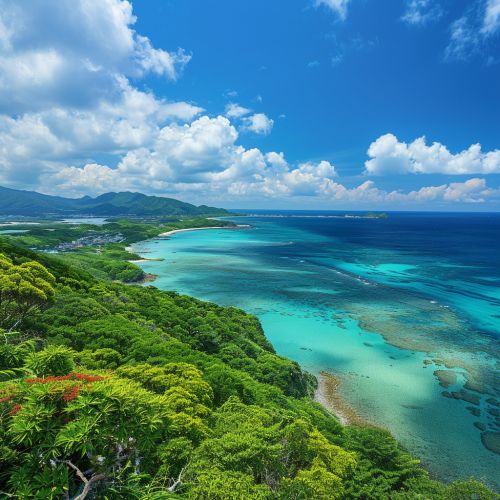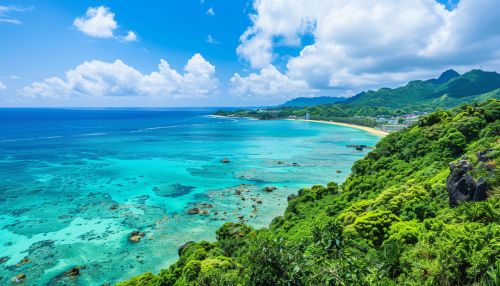Ryukyu Islands: Difference between revisions
No edit summary |
No edit summary |
||
| Line 2: | Line 2: | ||
The [[Ryukyu Islands]] are a chain of islands that stretch southwest from [[Kyushu]] (one of the main islands of Japan) to [[Taiwan]]. The archipelago is divided into three major groups: the Northern, Central, and Southern Ryukyus. The largest of the islands is [[Okinawa Island]], which is also the most populous and economically developed. | The [[Ryukyu Islands]] are a chain of islands that stretch southwest from [[Kyushu]] (one of the main islands of Japan) to [[Taiwan]]. The archipelago is divided into three major groups: the Northern, Central, and Southern Ryukyus. The largest of the islands is [[Okinawa Island]], which is also the most populous and economically developed. | ||
[[Image:Detail-77743.jpg|thumb|center|A picturesque view of Okinawa Island, with its lush greenery and clear blue waters.]] | [[Image:Detail-77743.jpg|thumb|center|A picturesque view of Okinawa Island, with its lush greenery and clear blue waters.|class=only_on_mobile]] | ||
[[Image:Detail-77744.jpg|thumb|center|A picturesque view of Okinawa Island, with its lush greenery and clear blue waters.|class=only_on_desktop]] | |||
== Geology == | == Geology == | ||
Latest revision as of 13:13, 7 May 2024
Geography
The Ryukyu Islands are a chain of islands that stretch southwest from Kyushu (one of the main islands of Japan) to Taiwan. The archipelago is divided into three major groups: the Northern, Central, and Southern Ryukyus. The largest of the islands is Okinawa Island, which is also the most populous and economically developed.


Geology
The Ryukyu Islands are part of the Ryukyu Arc, a volcanic island arc that covers more than 1,200 kilometers. The arc is the result of the Philippine Sea Plate subducting beneath the Amurian Plate and Okinawa Plate. The islands are primarily composed of limestone and are known for their unique karst formations.
Climate
The climate of the Ryukyu Islands is classified as a tropical rainforest climate. The islands experience high temperatures and humidity throughout the year, with a distinct rainy season from May to June. Typhoons are common from July to October, which can cause significant damage.
Flora and Fauna
The Ryukyu Islands are home to a rich diversity of flora and fauna, many of which are endemic to the region. The islands are part of the East Asian-Australasian Flyway, an important migratory route for birds. The Iriomote cat, a critically endangered species, is found only on Iriomote Island in the Southern Ryukyus.
History
The history of the Ryukyu Islands is marked by periods of independence, tributary relations with China, and rule by Japan. The Ryukyu Kingdom, established in the 15th century, was a significant trading state in East Asia. The kingdom was annexed by Japan in the late 19th century, and the islands have been under Japanese administration since, with the exception of the post-World War II period when they were governed by the United States.
Culture
The Ryukyu Islands have a distinct culture that differs from mainland Japan. This is reflected in the islands' unique Ryukyuan languages, traditional dance, music, and cuisine. The traditional religion of the islands incorporates elements of animism, ancestor worship, and Buddhism.
Economy
The economy of the Ryukyu Islands is largely dependent on tourism, agriculture, and the presence of U.S. military bases. Okinawa Island, in particular, is a popular tourist destination known for its beautiful beaches, coral reefs, and historic sites.
